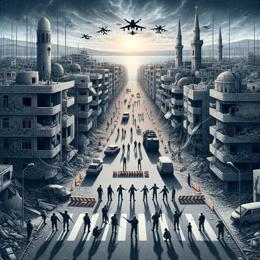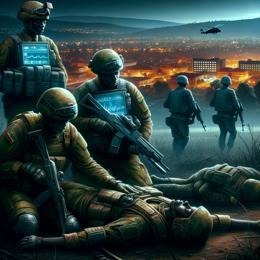Image created by AI
Escalation in Lebanon: Israeli Jets Strike Hezbollah Targets in Eastern Lebanon
In what marks a significant escalation in hostilities, Israeli jets have conducted airstrikes in eastern Lebanon, targeting Hezbollah positions near Baalbek—a stronghold for the Iran-backed Shia group and approximately 100 kilometers from the border with Israel. The airstrikes resulted in at least two fatalities and come amidst ongoing tensions since the beginning of the war in Gaza in October last year.
Lebanese security officials confirmed the attacks, clarifying that this is the first-time Israeli forces have launched airstrikes on eastern Lebanon since hostilities intensified with Gaza. The targeted facilities included a convoy of trucks and a Hezbollah warehouse within the Bekaa Valley, which, according to a Hezbollah official, is involved in the Sajjad Project—an initiative for distributing subsidized food products to the local population.
Israel's military released a statement claiming the airstrikes were a response to an earlier incident where Hezbollah shot down an Israeli drone over southern Lebanon using a surface-to-air missile. Notably, this southern region had predominantly been the focus of Israeli military operations, making the strikes on Baalbek particularly significant.
Videos and images circulated on social media depict heavy smoke plumes and destruction in the area following the airstrikes. The visuals showed the remnants of annihilated vehicles and large mounds of rubble from buildings.
The deadly sortie follows a sequence of hostile interactions that unfolded on the same day. Earlier, Hezbollah claimed to have downed an Israeli drone over its territory, and another Hezbollah-fired missile was deflected by Israeli defenses, landing without causing harm or destruction near a synagogue in northern Israel.
Hezbollah quickly vowed retaliation for the airstrikes, launching a volley of Katyusha rockets from southern Lebanon into the Israeli-occupied Golan Heights. The Israeli military corroborated reports of rockets launched towards their positions.
The ongoing confrontation between Hezbollah and Israeli forces near the Lebanon-Israel border has been a nearly daily occurrence since the war in Gaza erupted on October 7, claiming the lives of at least 47 civilians to date. As Gaza remains in turmoil, with a ceasefire apparently out of reach, the flashpoints between Israel and Hezbollah in Lebanon are igniting fears of a broader regional conflict.
Israeli authorities have made it clear that they do not equate a potential ceasefire in Gaza to any decrease in vigilance or military operations on other fronts, with Israeli Defence Minister Yoav Gallant explicitly stating that assumptions of a concurrent truce extending to Lebanon are misguided.
The region remains in a delicate balance, teetering between hostile engagements and the search for stability. With the death toll rising and the geopolitical lines being redrawn with every military action, international concern is growing for the civilians caught amidst this increasing cycle of violence.
#GOOGLE_AD










